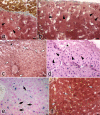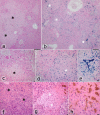Liver Histopathological Changes Related to Intraperitoneal Administration of Salicylic Acid/Fe3O4 Nanoparticles to C57BL/6 Mice
- PMID: 36320876
- PMCID: PMC9590356
- DOI: 10.12865/CHSJ.48.02.02
Liver Histopathological Changes Related to Intraperitoneal Administration of Salicylic Acid/Fe3O4 Nanoparticles to C57BL/6 Mice
Abstract
With a simple synthesis and easy engineering of physicochemical properties, iron oxide nanoparticles (IONPs) have become widely used in multiple biomedical applications. The study of IONPs toxicity has become an important issue, especially as the results reported so far are contradictory and range from lack of toxicity to cellular toxicity. The aim of this study was to evaluate the histopathological changes induced in mouse liver by long-term intraperitoneal injection of low doses of IONPs functionalized with salicylic acid (SaIONPs). The study was performed on C57BL/6 mice that received by intraperitoneal injection (IP), every two days, 0.6ml of SaIONPs aqueous suspension (35mg/kg body weight SaIONPs that contained 20mg/kg body weight of Fe3O4) for 28 days. The results of this study showed that the cumulative dose of 105mg/kg body weight SaIONPs (62mg/kg body weight of Fe3O4) induced histopathological changes in the subcapsular region of the mouse liver, possible by the release of salicylic acid into the peritoneal cavity. The cumulative dose of 244mg/kg body weight SaIONPs (145mg/kg body weight of Fe3O4) induced liver centrilobular necrosis, which requires the use of lower doses in biological applications. However, this may prove to be beneficial in the case of targeted accumulation of SaIONPs.
Keywords: Iron oxide nanoparticles; hidropic degeneration; rat liver; salicylic acid; toxicity.
Copyright © 2014, Medical University Publishing House Craiova.
Conflict of interest statement
None to declare.
Figures




Similar articles
-
The Histological and Biochemical Assessment of Monoiodoacetate-Induced Knee Osteoarthritis in a Rat Model Treated with Salicylic Acid-Iron Oxide Nanoparticles.Biology (Basel). 2024 May 10;13(5):331. doi: 10.3390/biology13050331. Biology (Basel). 2024. PMID: 38785813 Free PMC article.
-
Administration Routes as Modulators of the Intrahepatic Distribution and Anti-Anemic Activity of Salicylic Acid/Fe3O4 Nanoparticles.Biomedicines. 2022 May 23;10(5):1213. doi: 10.3390/biomedicines10051213. Biomedicines. 2022. PMID: 35625949 Free PMC article.
-
Toxicity and biodistribution assessment of curcumin-coated iron oxide nanoparticles: Multidose administration.Life Sci. 2021 Jul 15;277:119625. doi: 10.1016/j.lfs.2021.119625. Epub 2021 May 17. Life Sci. 2021. PMID: 34015288
-
Surface engineering of magnetic iron oxide nanoparticles by polymer grafting: synthesis progress and biomedical applications.Nanoscale. 2020 Jul 23;12(28):14957-14975. doi: 10.1039/d0nr03346d. Nanoscale. 2020. PMID: 32648868 Review.
-
Toxicology and carcinogenesis studies of androstenedione (CAS No. 63-05-8) in F344/N rats and B6C3F1 mice (gavage studies).Natl Toxicol Program Tech Rep Ser. 2010 Sep;(560):1, 7-31,33-171 passim. Natl Toxicol Program Tech Rep Ser. 2010. PMID: 21037592 Review.
Cited by
-
The Histological and Biochemical Assessment of Monoiodoacetate-Induced Knee Osteoarthritis in a Rat Model Treated with Salicylic Acid-Iron Oxide Nanoparticles.Biology (Basel). 2024 May 10;13(5):331. doi: 10.3390/biology13050331. Biology (Basel). 2024. PMID: 38785813 Free PMC article.
-
Calorie restriction mimetics against aging and inflammation.Biogerontology. 2025 Jun 24;26(4):126. doi: 10.1007/s10522-025-10269-0. Biogerontology. 2025. PMID: 40553215 Review.
-
Liver-targeting iron oxide nanoparticles and their complexes with plant extracts for biocompatibility.Beilstein J Nanotechnol. 2024 Dec 11;15:1593-1602. doi: 10.3762/bjnano.15.125. eCollection 2024. Beilstein J Nanotechnol. 2024. PMID: 39691205 Free PMC article.
References
LinkOut - more resources
Full Text Sources
